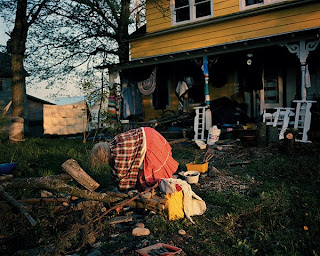Tierney Gearon is an American photographer who came to prominence in Britain after a media controversy over her work at the Saatchi Gallery.
She was born in Atlanta, Georgia. She had no formal art training, but studied ballet in Utah, where a European model agency saw her. This led to five years of modelling and travelling the world. During this time she took up photography herself. A Paris agent saw some of her Polaroid photos and encouraged her to do more work. She then became a fashion photographer for five years. Her work was used in magazines and on Times Square billboards.
Large blow-ups of her photos of her two children were exhibited in the show I Am a Camera at the Saatchi Gallery in March 2001. These included two naked poses and one of her son urinating in the snow. There were three complaints by members of the public, and the police visited the gallery twice, causing a great deal of media coverage, debating the rights and wrongs of such work, generally in favour of Gearon. The press reported police threats to seize the work, but this was denied by the police and no further action was taken.
The family snapshots of Tierney Gearon have only recently come to the attention of the artworld through her significant presence in the ‘I Am A Camera’ exhibition at the Saatchi Gallery in London in spring 2001, but her work has a strength and conviction that belies her newcomer status.
Born in Atlanta, Georgia in 1963, Gearon has led a predominantly mid-Atlantic life that was kick-started when she was spotted by a European modeling agency while studying ballet in Utah. It was during some five years of traveling the world through her modeling work that Gearon first became interested in life on the other side of the camera. An agent in Paris, impressed by a small scrap book of Polaroid photographs Gearon had taken of other models she worked with, encouraged her to extend her repertoire and she was launched into the world of fashion photography, earning respect from many of the most influential fashion houses and producing work for Times Square billboards and publications such as i-D.
After five years of jet-setting as a busy commercial photographer, Gearon not only felt the fashion world had taught her everything it could, but also met and married a Frenchman (whom she has since divorced), settled down for the first time and had a family – Emilee, who is seven years old, and Michael, now four. Following what proved to be an emotionally difficult time after the birth of her two children and the break-up of her marriage, Gearon began the highly personal project that launched her, unsuspecting, into an artistic career. The documenting of her extended family has acted as a personal journey for herself and for her family as well, both in a literal and emotional sense.
Structured around journeys with her children to and from the homes of distant and diverse relatives – predominantly across the United States – her images show lives comprised of both comfort and confusion. Little in Gearon’s pictures could be called out-of-the-ordinary: we see the generations of her family hanging out on the beach, going skiing, talking by the pool, and watching TV. There is no documentary grittiness in these bright Technicolor shots, whose backdrops range from sun-drenched beaches to the white ski slopes of the Alps, but there is an edginess at play that goes beyond the snap-happy impressions offered at first glance. Children stand naked on a beach against the backdrop of an azure sea: a family snap indeed, except that the children are wearing identical Disney masks and stare directly out towards the viewer, unexpectedly reflecting our quizzical glance back at us.
In her photographs as in her life, Gearon’s children form a powerful presence among the domesticity. They roam free, play-act and play up, sometimes to the camera and sometimes to the adults they find around them. Masks are again used as props: an old man, hiding his face behind a mask in the shape of a bird’s beak, looks down toward a young boy dressed in Sesame Street underpants. The boy faces away from the camera and stares up at his elder – we do not see his face, but from his confident pose we feel that it is actually the man who is hiding from his younger counterpart.
These children are not sentimentalized and neither are the adults alongside them. Gearon’s talent lies in an ability to capture life with all its surreal twists and confusions, as negotiated by young people in an adult world. A boy stands forlorn by a poolside while his grandfather speaks on his mobile. Two children look down at an animal laying dead at the roadside: the girl points her fingers in the shape of a gun and the young boy removes his wolf mask, both are confused and intrigued by the body in front of them. In another image a boy stands like a neoclassical cherub on a patio wall, looking down with a nonchalant glance from his ‘pedestal’ at an adoring middle aged woman standing below.
These images are highly personal, keyed to Gearon’s own life, reflecting its apparently equal helpings of chaos and stability. But they also remain strangely anonymous and distant. They speak of particulars but also tap into ubiquitous questions about life. Freezing these moments seemingly through children’s eyes, Gearon presents us with the children’s complex mixture of innocence and insouciance, which comes from experiences as yet unmediated by grown-up sensibilities. Any questions we have as we look into these images are bounced back at us as the young counterparts concentrate on life lived.




















